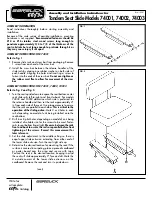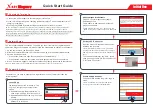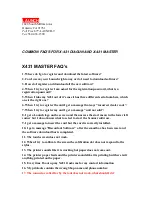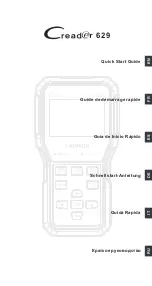
Page 16 of 41
Medusa 510/511 Series Iss.11 – 07/12
THERMOMETRIC FIXED POINTS
(a tutorial note)
Temperature scales used in science and industry are defined by a series of "fixed points", which are realised by
establishing thermal conditions under which pure materials exhibit equilibrium between two or three phases. A scale
assigns numerical values to the temperatures at which these phase equilibria exist. For example, the temperature at
which pure water exists simultaneously in its liquid, solid and gas phases (triple point) has been assigned the numerical
value of 0.01°C on the International Temperature Scale, and the value of 273.16K on the Kelvin Thermodynamic
Temperature Scale. Examples of other defining fixed points of the International Temperature Scale of 1990 are the
respective liquid-solid equilibria of tin, zinc and silver under 1 standard atmosphere pressure.
In some important disciplines it is desirable to realise a thermometric fixed point between 0 and 100°C, frequently in
the vicinity of body or environmental-temperature. The melting temperature of high purity gallium, 29.7646°C, is a
fixed point that can be useful in this context.
The solid-liquid equilibrium point of gallium is realised in cells such as those shown in figure 1. A quantity of pure
gallium is contained in a vessel which provides, also, a re-entrant well for insertion of a thermometer. The cycle for
realising the melt equilibrium is as follows:
The gallium starts in a single phase, assumed for present purposes to be liquid. The cell is placed in a cold
environment until the gallium has solidified. The phase-change of the metal can be determined by tracing the
temperature of the well. As the metal cools from the liquid phase, the temperature will begin to fall. An initial
smooth drop in temperature will be observed, and then at some temperature below the freezing temperature there
will be seen a reversal and a subsequent rise in temperature. This "undercool" phenomenon is characteristic of many
pure materials, most of which can remain liquid at temperatures below their normal freezing points (if the metal were
initially solid, the temperature would fall uninterruptedly to that of the cold environment).
The reversal takes place as the first crystalline solid forms in the liquid; the temperature rises to the liquid-solid
equilibrium plateau temperature as the metal gives up latent heat on freezing, remaining thereafter at this
temperature until the metal is completely solid. Beyond this stage there will be a smooth drop in temperature to that
of surrounding environment.
To establish the melting condition, the cell is then transferred to an environment maintained at a temperature slightly
above the melt temperature of gallium. This environment may be a stirred fluid bath of sufficient heat capacity and
control capability, or may be the Medusa POTTS or Gallium Temperature Standard Apparatus Model 17402B which
is designed automatically to raise the temperature of the cell to initiate melting of the metal and then to maintain it at
a correct level. The temperature to which the cell is exposed to melt the metal does not determine the solid-liquid
equilibrium temperature, but it can have a substantial effect on the duration of the (constant-temperature) melt
plateau.
The monitoring thermometer will indicate a rise in temperature in the well as the solid gallium approaches the melt
temperature. Then, beyond the instant at which liquid first begins to form, the temperature will remain constant until
all the metal has melted. The end of the melt plateau is signalled by a rise in well temperature to the temperature of
the surrounding environment. An ITL 17401 gallium cell used in the Model 17402B system can give a plateau duration
of at least 12 hours.
The melting cycle is now complete. The material in the cell is entirely in the liquid phase. Another cycle may be
started immediately, if desired.
17cc of water should be poured into the re-entrant tube to allow proper conduction between cell and thermometer.
For the highest accuracy measurements (to less than 0.1mK of the ITS-90 value) an hour should elapse between
switching to melt and commencing measurements. Alternatively, once the melt has began the water in the well can
be replaced by warm water at say 40°C to initiate a melt round the re-entrant tube. See CCT96/8 for additional
guidance.
















































